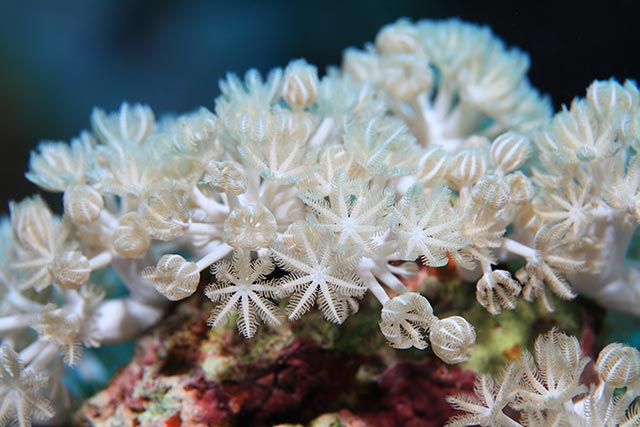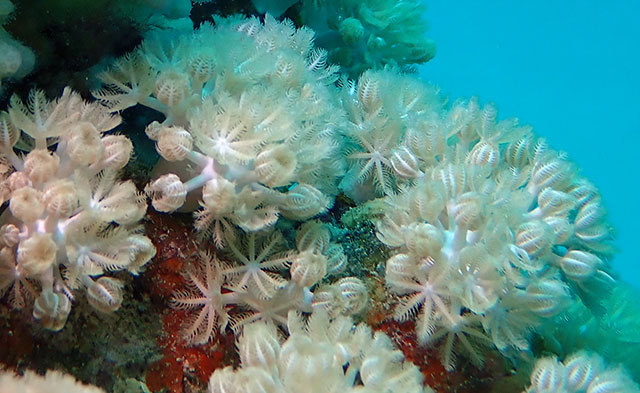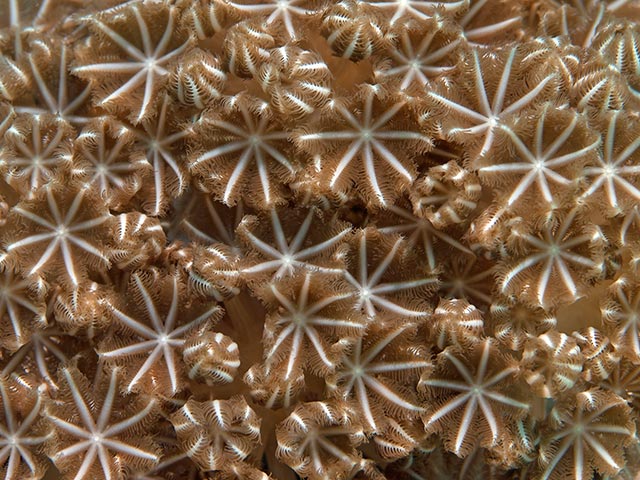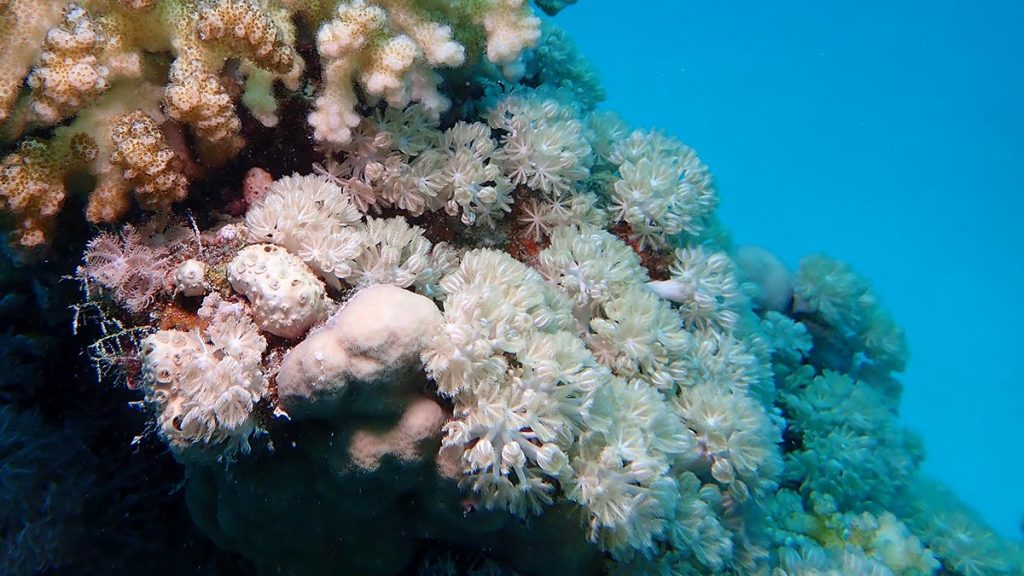If you’ve dived in the Red Sea or Indo-Pacific you will have seen pulsating soft coral repetitively “grabbing” at the water. They are so common that we take them for granted. But only one family of coral does this – the Xeniidae. Even within this family, only a few members pulsate. Those that do include the Pulsating Xenid or Heteroxenia fuscescens and the Umbrella xenia, Xenia umbellata.
 Image: DepositPhotosImage: DepositPhotos
Image: DepositPhotosImage: DepositPhotosScientists have long assumed that these Xenids rhythmically pulsate to create a current to assist feeding and respiration. This is a very costly strategy, though, in terms of energy used. Until now it wasn’t known exactly how much, and exactly what, benefit the coral gets from working this hard.
The mystery was solved by researchers from the Hebrew University of Jerusalem and the Technion-Israel Institute of Technology. They made several discoveries about the Pulsating Xenid and found that thanks to pulsation, the ratio between photosynthesis to respiration in Heteroxenia fuscesens is the highest ever measured in both hard, and non-pulsating soft, corals.

After watching several coral colonies with an underwater infrared-sensitive camera night and day, the researchers found their first surprising discovery: Heteroxenia corals cease to pulsate and take a half-hour break every single day in the afternoon hours. At this stage, the afternoon “siestas” remained unexplained.
In order to solve the mystery of the Heteroxenia coral, the research team developed an underwater measuring device called PIV (particle imaging velocimetry), which allows measurement of the flow field just around the coral very accurately. The system comprises two powerful lasers, an image capturing system and computation ability. A special set of lenses releases a sheet of light in short, powerful pulses so that the imaging system can capture pairs of snapshots of natural particles moving with the flow. The computational system then performs a mathematical analysis of the pairs of photos, producing a huge database of flow field maps, from which the flow speed, characteristics of solutes transport, and turbulent mixing intensity are calculated.

The measurements were performed at night with the support of volunteer divers. They found that if a diver lightly touched the coral, the polyps “close” and remain motionless for a few minutes, after which the coral returns to its normal pulsation activity. The researchers used this behaviour in order to repeatedly measure the flow field around the Heteroxenia during pulsation and rest.
These measurements led to the research group’s next discovery. Analysis of the direction of water flow indicated that the motion of the polyps effectively sweeps water up and away from the coral tissues into the ambient water. Corals need carbon-dioxide during daytime and oxygen during nighttime, as well as nutrients (such as phosphate and nitrogen) during day and night. One of the challenges for coral colonies is to render their surrounding waters rich in essential commodities by efficiently mixing the water around them.
 Image: DepositPhotosImage: DepositPhotos
Image: DepositPhotosImage: DepositPhotosAnother unexpected discovery was that even though the polyps’ motions are uncoordinated (i.e. each polyp starts its period of motion at a different time), the accumulated effect of the polyps’ activity is a significant enhancement of the flow around the colony, particularly in the upward direction which sweeps water away from the coral, hence reducing the probability of re-filtration of the same water.
However, these findings still did not yet answer the question of why a coral would invest so much energy to move its tentacles. After receiving a permit from the Israel Nature and Parks Authority, the research team collected a few Heteroxenia colonies from the sea in order to run a series of laboratory experiments. All corals were returned back to their original location after the experiment terminated. The Hypothesis was that the pulsation motions enhance the coral’s photosynthesis rate.
Corals “host” photosynthetic algae in their tissues. The symbiotic algae provides the coral with essential nutrients and lives off the waste of the coral.
A previous study found that the motion of water around corals is essential in order to enhance the removal of oxygen from the coral tissues. Without water motion, the oxygen concentration in the coral tissues would rise and the photosynthesis rate would drop.
The answer to the question as to why the Heteroxenia pulsates was finally revealed through the lab experiments. First, the photosynthesis rate of a pulsating Heteroxenia was measured, and it was found to be on an order of magnitude higher than that of a non-pulsating colony. Next, in order to prove that the mechanism of pulsation is intended to sweep away oxygen, the researchers artificially increased the oxygen concentration in the measurement chamber so that even when the coral managed to mix water via pulsation, it was replacing oxygen-rich water with new water, which, unfortunately for the coral, was also rich in oxygen. And indeed it was found that the photosynthesis rate was low in this case, and even when the coral was constantly pulsating, the oxygen concentration remained high and photosynthesis remained low, as if the coral was at rest (i.e. not pulsating).
The elegant motion of Xenids has been fascinating the scientific society for over 200 years. The first Xeniidae colonies were collected during Napoleon’s invasion of Egypt during the years 1798-1799 when specimens of Xenia umbellata were brought back to Europe. Both specimens were given brief descriptions by Lamarck in 1816 and accompanied by detailed drawings of the colonies and their polyps. In spite of this it had not been explained. Now, in the study of Kremien, Genin and Shavit, it is known that the pulsation motions augment a significant enhancement in the binding of carbon dioxide to the photosynthetic enzyme RuBisCo, also leading to a decrease in photorespiration. This explanation justifies the investment of energy in pulsation — the benefit overcomes the cost.
The next time I dive in the Red Sea I’ll look more carefully at these unique animals.
Further Reading:
Israeli scientists discover why soft corals have unique pulsating motion
Biological Sciences – Ecology: Maya Kremien, Uri Shavit, Tali Mass and Amatzia Genin. Benefit of pulsation in soft corals PNAS 2013 ; doi:10.1073/pnas.1301826110
Coral Guide Red Sea by Lieske and Myers, 2004
Proceedings of the 12th International Coral Reef Symposium, Cairns, Australia, 9-13 July 2012. Synopsis of the Family Xeniidae (Cnidaria: Octocorallia): Status and Trends. Michael P. Janes, Anita G. Mary
Pulsating Xenia Coral, Xenia umbellata
Image credits:
- xenia: Jill Studholme | CC BY 4.0 International
- xenia-dp: DepositPhotos
- heteroxenia-dp: DepositPhotos
